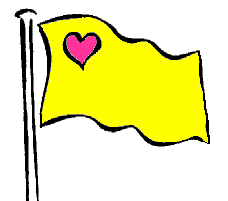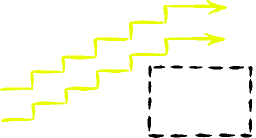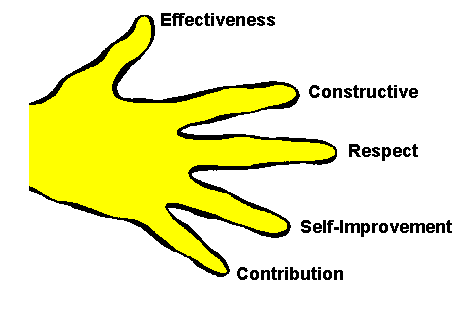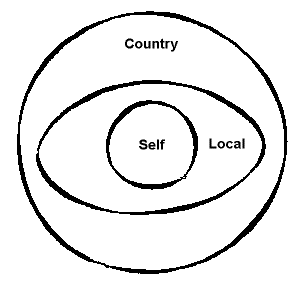

The positive revolution is a worldwide revolution promoted by Edward de Bono in his book, Handbook for the Positive Revolution (1991), also known as "the Yellow Book." It is the culmination of many of his approaches to the future, in particular his notion of "The Happiness Purpose."

The common current way of solving problems and differences is through the use of opposing forces in conflict. This was the negative revolution. Force is applied to an enemy with a goal of overthrowing it by using overwhelming power in direct confrontation. This system requires two polarized "sides" which attack each other head-on.
The positive revolution is a new paradigm of the use of a variety of forces to go around the enemy and solve problems in new ways. The focus is not on vanquishing the enemy, but on building a better structure. The energy is directed toward construction rather than destruction.

(See Yellow Book introduction)
An emphasis on negativity seriously impedes progress. In order to go forward, we need to develop and nurture creative, constructive, and design energies instead of energies spent in destruction and conflict.
Humanity needs to change its perceptions and values, placing higher worth on that which is constructive and creative. An emphasis on productiveness supports progress, because the more you invest in the positive revolution, the more you (and everyone else) will get out of it. Furthermore, it's fun! The world would spin on its axis a bit easier if there were more fun and laughter.
In a positive revolution, there are no enemies.
(See Yellow Book introduction)
In our current system, people in power use their resources and intelligence to defend their position and survive. They look after their own interests shortsightedly, without taking a longer view of the impact their actions have on the greater world. Intelligent people, who should know better, sling mud, confuse issues, attack, criticize and blame others.
Negative revolutionaries also take themselves too seriously. In our current system, having a light heart and a sense of humour often precludes getting your voice heard in the halls of power.
Many participants in our system seem to believe it's a "zero-sum game." In game theory, a "zero-sum game" is one in which someone must be defeated in order for someone to win. In other words, the winner takes all, and all other players lose. Another way to look at it is as if the "prizes" in the game are finite, and so what is gained by the winner is lost by the loser. Life is not like this; win-win solutions and compromises are possible, and usually preferable.
Our Western system is like two people in a tug of war: both sides are expending a lot of energy, but nobody is accomplishing or producing much.
(See Yellow Book, pp. 1-7)
No. Political parties encourage polarization and regarding other parties as "the enemy." It is possible to use the techniques of the positive revolution to work toward a variety of particular goals, apart from or in concert with specific political agendas.
Also, making the positive revolution a political party would encourage polarization by creating an "Us and Them" mentality; it's more in tune with the positive revolution's principles to help standing parties work together toward common positive goals. Furthermore, since the goals of the positive revolution are wide-based, constructive and positive, it's reasonable to believe that all other parties would benefit from working toward them. If a party cannot support positive goals, it becomes necessary to question the basis of that party, and for the party to explain why it clings to negative goals.
The FAQ maintainers believe that political factions themselves are indigenous to the modern political scene, yet not in keeping with the positive revolution's long-term success. Particularly in the United States, two-party politics leads to extreme polarization, with political action committees, lobbies, and similar groups affecting the system as more parties might in another system (but with less real power for minority groups). We believe that the melting of party lines, and the eventual obsolescence of insular political factions, should be an early step toward a more positive future.
(See Yellow Book, pp. 152-154)
In essence, old-style revolution is concerned with hard forces directed in narrow channels toward a provided goal. By contast, the positive revolution is concerned with more organic action and creativity, and generating situations that inspire and nurture growth.
Some examples:
(See Yellow Book, pp. 6-7)
The positive revolution is built on three solid foundations -- Principles, Methods and Power -- in the same way a stool has three legs that make it stable on rough ground.
(See Yellow Book, p. 9 and forward)
The symbol of the positive revolution is the open hand. The five principles can be mapped onto the fingers to help remember them.

(See Yellow Book, pp. 11-13)
As a painter uses a paintbrush to paint and a carpenter uses a saw to cut wood, a revolutionary needs tools to create revolution. The tools used in the positive revolution are many and include the following methods:
(See Yellow Book, pp. 61-118)
Construction is action used in building and making things happen, always in the positive sense. Activity by itself is not necessarily constructive; to determine if an action is constructive, ask what is created when the activity is over. For example, a tug-of-war is not constructive, although in the sense of recreation and fun, it might be considered constructive. Passively watching television is generally not constructive, but time-filling instead. Planting a seed, cooking a meal, and creating a piece of art are all constructive.
Construction is the true opposite of drift, so in order to be effective, action must move in a direction. A person must choose to direct action positively, rather than allowing a passive drift, or choosing to act negatively. Acting negatively is often much easier than acting positively -- which demands effort and construction rather than just talk and destruction -- so people commonly fall into the habit of negativity or passivity, allowing themselves to simply drift through situations.
Without action, there is no revolution, only dissipated energy. Therefore, action in the positive direction fuels the positive revolution.
It's beginning to sound like the positive revolution is all effort and concentration, and lots of hard work. In fact, being happy while working toward positive goals is very important. It is important to make positive decisions, but also to enjoy life, friends, entertainment and so on as well; it asks no more of you than what you can afford to give at the moment, and reminds us that every contribution is valuable, no matter how small.
Many people have found that pursuing enjoyment as a total purpose robs them of the ability to truly enjoy a rich life. Achievement is one of life's more durable joys, and achievement comes through construction.
(See Yellow Book, pp. 14-19)
Self-improvement can take many forms. Here are four possible ways of improving the self:
Slow, day-to-day self-improvement is a good goal.
(See Yellow Book, pp. 43-44)
While the general goal of self-improvement should be toward refocusing attitudes and actions in a positive direction, it's often helpful to break down that goal into smaller components. There are many paths to this goal, and they tend to include the following:
(See Yellow Book, pp. 45-46)
Effectiveness is setting out to do something and doing it. Effectiveness requires:
Set yourself small steps and carry them out. When you've completed something, pause and say: "I have done that task and I have done it well."
The joys of effectiveness include:
(See Yellow Book, pp. 33-39)
Of any action, ask:
Of a person, ask:
(See Yellow Book, p. 26 and pp. 74-81)
Circles of concern indicate areas in which a contribution's effect is felt. There are three concentric circles: Self, Local, and Country/World (see below):

The circles are concentric to indicate that a contribution often affects more than one area. For example, if you learn to read and write, it is a contribution to your country as well as yourself. This model reminds us that contributions that seem small and personal often have wider influence than we may think.
(See Yellow Book, pp. 24-26)
A revolution needs symbols for several reasons: to spread the revolution; to give a sense of identity and belonging to those who have joined it; to remind those taking part of its principles; to provide a way for any member to make a small contribution; and to provide a basis for power by showing the level of support the revolution has.
The symbols of the positive revolution are the following:
As an alternative to the yellow armband that serves the same function, Winged Elephant Designs has created a bracelet of mixed yellow beads, representing a union of individuals sharing positive energy and goals. The bracelet is appropriate for both genders, and can optionally include the flag's pink heart.
(See Yellow Book, pp. 83-89)
An E-Club is an "effectiveness club" that acts as a support group for people engaging in constructive action. It's made up of members who meet periodically to set tasks for themselves and report on progress. Thinking and planning tasks as well as difficulties, problems, and achievements are reported back and shared with other members.
Some reasons for forming an E-Club include the following:
There are explicit rules and instructions for setting up an E-Club in the Yellow Book. The original FAQ reproduced some of that material, but the present maintainers have opted omit it and refer readers to the original text because of copyright considerations and because it is more complete. If you run an E-Club, you will want a copy of the Yellow Book in any case.
If you start an E-Club, let us know! We hope to maintain an informal directory of E-Clubs, in addition to de Bono's official one.
(See Yellow Book, pp. 167-176)
You can buy it new from Amazon.com.
Note: As of August, 1998 the book ships in two to three days. Amazon seems to have found a reliable source for this book.
Alternatively, excellent places to buy the Yellow Book used include Bookfinder.com and Bibliofind, both of which are huge databases of millions of used books from booksellers internationally. There are usually several copies in each database, so you should be able to get a copy right away.
These books are listed here because they contribute to the positive revolution in the opinions of the maintainers of this FAQ. No assumption should be made about whether the authors below have even heard of the positive revolution, much less endorse it explicitly, unless otherwise stated.
Altman, Nathaniel. The Nonviolent Revolution. Element Books Limited, Great Britain, 1988. (Excellent book on political action via ahimsa, the principle of harmlessness to all living beings.)
Fisher, Roger and Ury, William. Getting to Yes : Negotiating Agreement Without Giving In. 1987, 1991, 1992. (Classic book on conflict resolution. Makes you realise that "win-win" is not just corporate jargon.)
Lao Tzu. Tao Te Ching. (There are many translations of this ancient Chinese classic, probably the world's greatest book on "water logic." Ron's favourite translation is by Jane English and Gia-Fu Feng. You can find some public-domain translations at The On-line Books Page.)
Malaclypse the Younger. Principia Discordia. Public domain; several editions, including ones from Loompanics Unlimited, Illuminet Press, and Steve Jackson Games. (Contemporary classic on Discordianism, a "ha-ha-only-serious" religion that shows the positive revolution's playful side at its best. Available online.)
Millman, Dan. Way of the Peaceful Warrior. H.J. Kramer, Inc.; Tiburon, California, USA, 1980. (An unusually accessible story about effectiveness and becoming effective.)
Moore, Michael. Downsize This!: Random Threats from an Unarmed American. Crown Publsihers; New York, USA, 1996. (Interesting thoughts and creative solutions from a one-man peaceful revolution. Wildly recommended by Marty. Moore once organised a multi-racial "Love Fest" right in front of a KKK encampment, in which he urged the KKKers to partake. Now that's courage! A true "peaceful warrior.")
Thornley, Kerry. Zenarchy. (Discordian classic on peace through universal enlightenment. Available online.)
Von Oech, Roger. A Whack on the Side of the Head : How You Can Be More Creative. 1992. (A seminal book on non-linear creative thinking and problem-solving.)
Wilson, Robert Anton. Prometheus Rising. Falcoln Press; Phoenix, Arizona, USA, 1983. (Mind-blowing. Absolutely mind-blowing. We will say no more.)
These links are listed here because they contribute to the positive revolution in the opinions of the maintainers of this FAQ. No assumption should be made about whether the authors of these websites have even heard of the positive revolution, much less endorse it explicitly, unless otherwise stated.
Center for Ludic Synergy ... an organisation devoted to games and play as political and salvific methods. Started by one of this document's maintainers.
Creativity Home Page ... page by one of the original maintainers of this document, Charles Cave. Centers on creativity and creative problem solving methods of all kinds.
Edward de Bono's Authorised Web Site ... de Bono is the author of the Yellow Book and founder of the positive revolution, which is only one of his interests! There are even more revolutionary ideas at this site.
New Civilization Network ... an extremely cool organisation that embodies the principles of the positive revolution. Has over 1800 members around the world as of June 1998.
Tools for Organizers, Activists, Educators, and Other Hell-Raisers ... huge repository of nuts-and-bolts information on how to conduct effective political action in a peaceful way. Useful for groups pursuing any positive goal.
Winged Elephant Designs ... sells positive revolution jewelry! (See the section on symbols of the positive revolution, above.) Owned by one of this document's maintainers.(NOTE: Winged Elephant Designs is an ally of the positive revolution and has offered this original design in support of it, but it should not be inferred that Edward de Bono or any organizations formally affiliated with him officially endorse this company or its products.)
The current maintainers of this document are Ron Hale-Evans ([email protected]) and Marty Hale-Evans ([email protected]), both of Seattle, Washington, USA. Email us if you have suggestions (or Ghoddess forbid, criticisms!) of this FAQ. Ron has a home page, and so does Marty.
The original maintainers were Charles Cave of Sydney, Australia ([email protected]) and Bill Paton of Canada ([email protected]).
The originator of the positive revolution concept is, of course, Edward de Bono, author of Handbook for the Positive Revolution.
Last updated 23 September 1999.